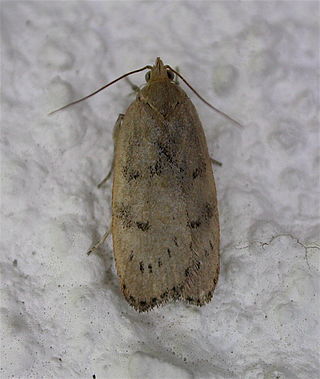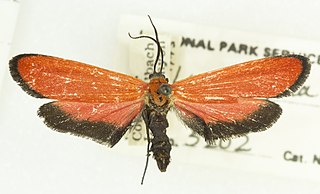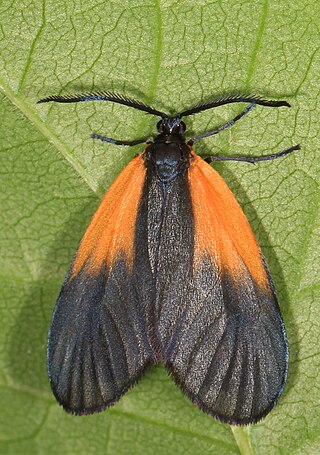
The Arctiinae are a large and diverse subfamily of moths with around 11,000 species found all over the world, including 6,000 neotropical species. This subfamily includes the groups commonly known as tiger moths, which usually have bright colours, footmen, which are usually much drabber, lichen moths, and wasp moths. Many species have "hairy" caterpillars that are popularly known as woolly bears or woolly worms. The scientific name Arctiinae refers to this hairiness. Some species within the Arctiinae have the word "tussock"' in their common names because they have been misidentified as members of the Lymantriinae subfamily based on the characteristics of the larvae.

The beet armyworm or small mottled willow moth is one of the best-known agricultural pest insects. It is also known as the asparagus fern caterpillar. It is native to Asia, but has been introduced worldwide and is now found almost anywhere its many host crops are grown. The voracious larvae are the main culprits. In the British Isles, where it is an introduced species and not known to breed, the adult moth is known as the small mottled willow moth.

Eacles imperialis, the imperial moth, is a member of the family Saturniidae and subfamily Ceratocampinae. It is found mainly in the East of South America and North America, from the center of Argentina to south Canada. The species was first described by Dru Drury in 1773.

The marbled beauty is a moth of the family Noctuidae. The species was first described by Johann Siegfried Hufnagel in 1766. It is an abundant species throughout most of Europe east to the Urals, and it is probably the most common lichenivorous moth of the Palearctic realm.

Lycomorpha is a genus of moths in the family Erebidae. The genus was erected by Thaddeus William Harris in 1839.

The elderberry borer, Desmocerus palliatus, is a species of Cerambycidae that occurs in Eastern North America.

Estigmene acrea, the salt marsh moth or acrea moth, is a moth in the family Erebidae. The species was first described by Dru Drury in 1773. It is found in North America, the Democratic Republic of the Congo, Kenya, Colombia, and Mexico.

Ctenucha virginica, the Virginia ctenucha, is a moth of the family Erebidae. The species was first described by Eugenius Johann Christoph Esper in 1794.

Schinia scutosa, the spotted clover, is a moth of the family Noctuidae. It is found from Europe to southern Siberia, the Near East and the Middle East and from central Asia to Japan. In North Africa it is found from Morocco to Egypt.

Idia americalis, the American idia or American snout, is a litter moth of the family Erebidae. The species was first described by Achille Guenée in 1854. It is commonly found in moist forests in North America, ranging from southern Canada to Florida and Texas. It is nocturnal and can be lured by sugar baits and light traps.

Phaeosaces coarctatella is a species of moth in the family Oecophoridae. It is endemic to New Zealand and can be found throughout the country. The preferred habitat of this species is native forest however they can also be found in domestic gardens. Larvae shelter in hollow twigs or under bark and emerge at night to browse on lichens. They pupate within their shelter. Adults are on the wing from September to January and are variable in their appearance. They vary both in colour, from reddish brown to a greenish yellow shade, and also in the extent of the black marking on their forewings. They are nocturnal and are attracted to light.

Manulea replana, the lichen-eating caterpillar or lichen moth, is a species of moth of the subfamily Arctiinae. It is found in Australia.

Declana atronivea, commonly called the North Island lichen moth or North Island zebra moth, is a moth of the family Geometridae. It is endemic to New Zealand and found only in the North Island.

Manulea bicolor, the bicolored moth or yellow-edged footman, is a moth of the family Erebidae. It is found in boreal North America, from Labrador and Massachusetts to Yukon and British Columbia. In the Rocky Mountains, it ranges south to southern Colorado. The habitat consists of boreal forests, parklands and riparian cottonwoods in the prairies.

Lycomorpha grotei, or Grote's lycomorpha moth, is a moth of the family Erebidae. It was described by Alpheus Spring Packard in 1864. It is found in North America, including Arizona, California, Colorado, Montana, Nevada, South Dakota, Texas, Utah and Wyoming.
Lycomorpha regulus is a moth of the family Erebidae. It was described by Fordyce Grinnell Jr. in 1903. It is found in North America, including Arizona, California, Colorado and Utah.
Lycomorpha splendens is a moth of the family Erebidae. It was described by William Barnes and James Halliday McDunnough in 1912. It is found in North America, including Arizona, California, Nevada, New Mexico, Texas and Utah.

Pyromorpha dimidiata, the orange-patched smoky moth, is a species of leaf skeletonizer moth of the family Zygaenidae found in eastern North America.

Trachypepla lichenodes is a moth of the family Oecophoridae first described by Edward Meyrick in 1883. It is endemic to New Zealand and has been found in both the North and South Islands. It inhabits native forest and adults of this species are on the wing from November to January. The adult moths are similarly coloured to native lichen species however this colouration is variable in the extent and depth on the forewings.

















